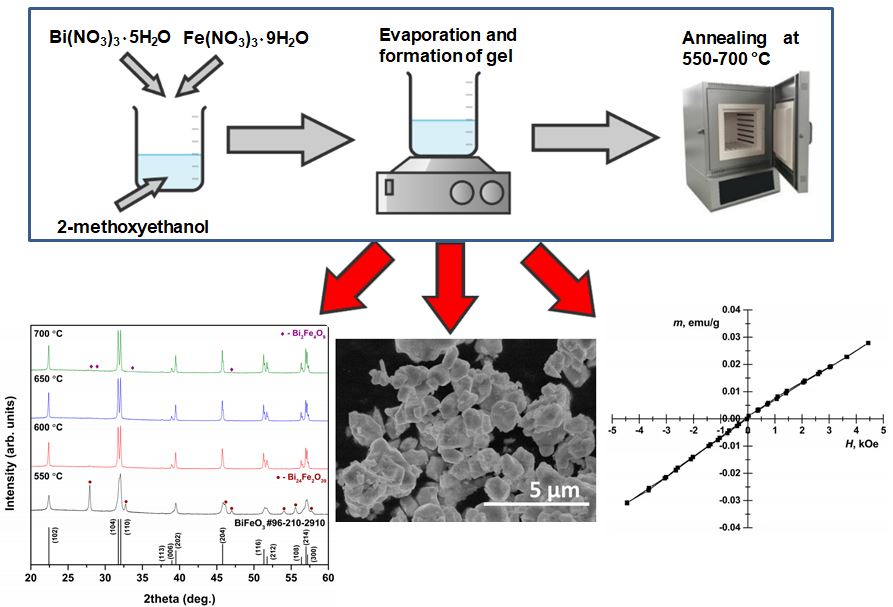Transition metal oxides with metastable phases:
a way towards superior ferroic properties
About the TransFerr Project
The main objective of the project is development of complex transition metal oxides with perovskite-like structure having improved and controllable (multi)ferroic properties. The mentioned materials are manganites and ferrites with optimal composition having distinct magnetization, polarization, (magneto)transport properties or magnetoelectric coupling.
The idea of the project is to utilize reduced structural stability of these oxides which increases their sensitivity to external stimuli. Improved functional properties of these oxides can be controlled via modification of the chemical bond character, structural parameters, stoichiometry, defects etc. The reduced stability is associated with the metastable structural state formed in the vicinity of the phase boundaries, while this state presumably consists of coexistent nanoscale regions of the adjacent structural phases.
There are two ideas to create metastable state: the first one – to design ceramics via chemical substitution and post-synthesis treatment by high pressure and/or thermal cycling in gases to induce nanoscale regions, the second one assumes chemical routes synthesis of films and ceramics. Besides the fundamental interest of the phase transitions and related phenomena affecting properties of the oxides the applicants consider them to be effective materials for electronic applications (as sensors, magnetic memory elements, filters etc.).
Research of these oxides requires consolidative efforts of specialists in different scientific areas – Materials Science, Theoretical Physics, Solid State Physics etc. as well as an access to unique equipment and facilities. Another important objective of the project is a formation of interdisciplinary network of teams and specialists (knowledge transfer) with different scientific (Physics, Chemistry, and Material Science) and business areas (e.g. Project Management, Risk Management, Team Leading) and from different countries (research centers and SME from Poland, Belarus, Portugal, Lithuania, Germany and Ukraine).
| TransFerr – List of Work Packages |
|||
|---|---|---|---|
| Work Package No. | Lead by | Title (WP Leader) | Duration time (months) |
| WP 1 | VU | Preparation of manganites and ferrites samples (A. Kareiva) | 1 – 36 |
| WP 2 | Hereon | Analysis of crystal and magnetic structure (M. Serdechnova) | 3 – 57 |
| WP 3 | ILTSR PAS | Investigation of electronic structure of the transition ions and physical properties of the compounds (Y. Gerasymchuk) | 6 – 61 |
| WP 4 | IOP | Modeling of the crystal structure and physical properties of the compounds (A. Morozovska) | 8 – 59 |
| WP 5 | UA | Evaluation structure-property relationship in doped transition-metal oxides (A. Kholkin) | 12 – 67 |
| WP 6 | NC | Optimization the samples preparation methods and procedures for up-scaling (P. Głuchowski) | 18 – 63 |
| WP 7 | ILTSR PAS | Knowledge dissemination, transfer of technology and innovations, public engagement (R. Tomala) | 3 – 69 |
| WP 8 | ILTSR PAS | Coordination, management and administrative procedures (A. Łukowiak) | 1 – 69 |
Main Project Results
In this study, a highly crystalline bismuth ferrite (BiFeO3) was prepared by novel, cost-effective and simple sol-gel synthetic approach. The optimal calcination temperature was determined to be 650 °C for formation of high-purity ferrite powder. BiFeO3 consisted of quite uniform particles with polyhedral shape. Magnetic measurements revealed that this compound is antiferromagnetic. Both X-Ray diffraction and Mössbauer studies showed the presence of Bi2Fe4O9 and Bi24Fe2O39 impurity phases. Optical band gap was evaluated on the basis of diffuse reflectance spectra of the BFO powders and calculated Eg value was 2.09 eV.
Materials (2020) 13, 3035 DOI: https://doi.org/10.3390/ma13133035
In this study, the morphotropic phase boundary in bismuth ferrite ceramics (BiFeO3) substituted with samarium was studied by Local and Microscopic approaches. Increase in samarium concentration leads to the structural transition from the polar active rhombohedral phase to the non-polar orthorhombic phase via a formation of metastable anti-polar orthorhombic phase. The morphotropic phase boundary region determined from the diffraction results is characterized by two concentration ranges having coexistent polar rhombohedral and anti-polar orthorhombic phases (0.12 ≤ x ≤ 0.15) and the antipolar and non-polar orthorhombic phases (0.15 < x < 0.18). Local scale measurements confirmed that morphotropic phase boundary region is characterized by wider concentration range, viz. 0.08 ≤ x ≤ 0.20 as compared to the results obtained by the microscopic methods. Notable difference in the results obtained by different methods is justified by the presence of the polar active and the non-polar regions in the compounds having single phase non-polar orthorhombic (x > 0.18) and the polar rhombohedral structural state (x < 0.12) respectively as determined by the diffraction measurements.
Journal of Alloys and Compounds (2021) 875, 159994


